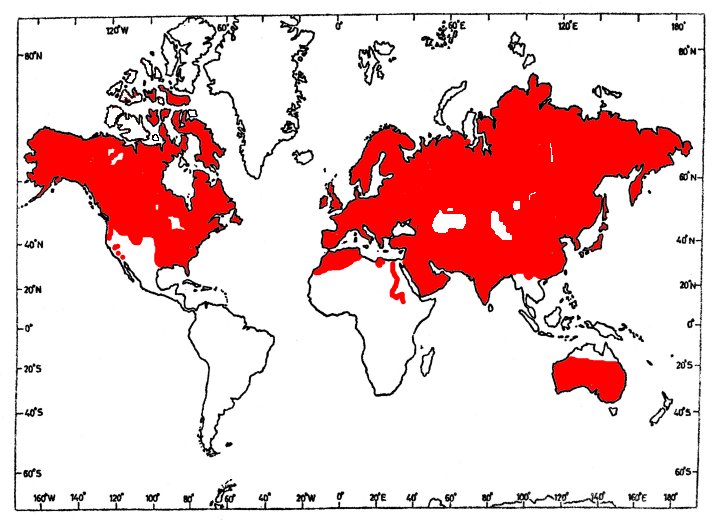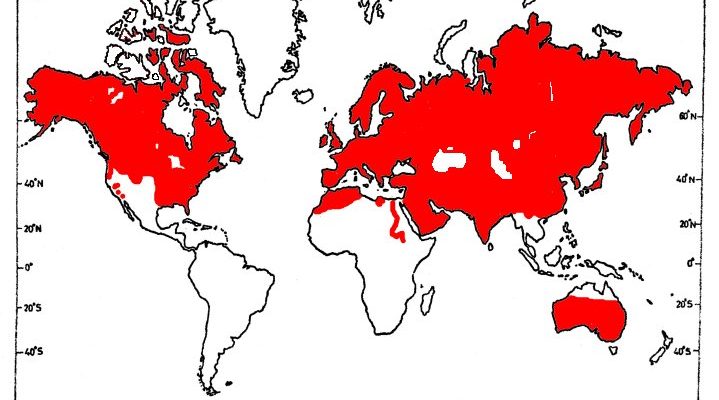
You might be wondering, what exactly makes a good home for a red fox? The answer is a mix of factors, including food sources, shelter, and space to roam. Let’s dive deeper into the habitats and distribution of red foxes, exploring where they find their cozy nooks and crannies around the globe.
Red Fox Habitat Overview
Red foxes prefer habitats that offer a combination of open and wooded areas. They’re quite the adaptable bunch! Generally, you can find them in a range of environments, including forests, grasslands, mountains, and even urban areas. This adaptability is one of the key reasons they are so widely distributed.
In forests, red foxes often make dens in the ground or utilize abandoned burrows from other animals. These burrows provide shelter from harsh weather and a safe place to raise their young. In more urban settings, you might spot them in parks or green spaces, where they can scavenge for food and have quick access to cover.
One interesting thing about red foxes is that they’re not picky eaters. They feast on small mammals, birds, fruits, and even some human food scraps. This varied diet lets them thrive in many different habitats, making them a common sight in various regions.
Where Are Red Foxes Found?
Red foxes have a broad distribution. They are native to North America, Europe, Asia, and even parts of North Africa. In North America, they can be found from Alaska down to Mexico and across various states in between. Each region offers its own unique landscape that the foxes have adapted to.
In Europe, red foxes are widespread, often found in rural and urban areas alike. They have also made their way into urban settings, where they can find food more easily due to trash and other human activities. Interestingly, in some parts of Asia, like Japan and China, red foxes are celebrated in folklore and culture, showcasing their importance beyond just their ecological role.
You might also be curious about how climate affects their distribution. In colder regions, red foxes grow thicker fur to insulate against the chill. Conversely, in warmer areas, they adapt by being more active during cooler parts of the day. This adaptability highlights their resilience and resourcefulness.
Urban Adaptability of Red Foxes
Let’s talk about how red foxes have managed to fit into urban environments. As cities expand, wildlife often gets pushed out. But not these foxes! They’ve become quite the urban dwellers. You might find them rummaging through your backyard or sneaking around city parks under the cover of night.
In urban settings, red foxes utilize parks, gardens, and even golf courses as their playgrounds. These green spaces offer food and shelter while providing a bit of distance from human activities. They often hunt small rodents and birds that inhabit these areas, showcasing their clever hunting skills.
However, living close to humans does pose challenges. Traffic can be dangerous, and urban foxes must navigate a world filled with potential hazards. But their ability to adapt and thrive in such environments truly demonstrates their intelligence and flexibility.
The Importance of Habitat Conservation
With the rising human population and urban development, the habitats of red foxes are increasingly threatened. It’s essential to understand that these animals play a vital role in ecosystems by controlling small mammal populations and contributing to the balance of their environments.
Conservation efforts focus on preserving natural habitats and ensuring that foxes can continue to thrive in their various environments. This includes protecting forests, wetlands, and grasslands, which provide food, shelter, and breeding grounds for red foxes and many other species.
Additionally, educating communities about coexistence with wildlife can help minimize conflicts. Simple actions like securing trash bins and respecting green spaces can make a big difference in helping red fox populations remain stable and healthy.
Fox Dens: Their Home Sweet Home
When we think of a red fox’s habitat, we often picture their dens. These cozy underground burrows are where foxes raise their pups and seek shelter. A den is typically strategically located in an area that offers security and easy access to food sources.
Dens can be found in various locations, from wooded areas to even under your porch in urban settings! You might be surprised to learn that red foxes often reuse the dens of other animals, like rabbits or badgers. They’ll add their own touch, but it helps them save energy that would otherwise be spent digging a new one.
These dens are crucial for fox families, providing protection from predators and a safe environment for raising their young. Fox kits are born blind and rely on their mother’s care during the early stages of life. This nurturing environment allows them to grow strong and learn essential survival skills before venturing out on their own.
Impact of Climate on Red Fox Distribution
Climate change poses an ongoing challenge for many species, including red foxes. As temperatures rise and weather patterns change, their habitats may be affected. Some areas may become less hospitable, pushing fox populations into new territories.
For instance, warmer winters could allow red foxes to expand their range further north, creating competition with other species, such as the arctic fox. Conversely, if food becomes scarce due to climate impacts, red foxes might struggle to find adequate resources, affecting their populations.
It’s essential for conservationists to monitor these changes and adapt conservation strategies accordingly. Understanding how climate affects wildlife distribution helps us make informed decisions about habitat preservation and management.
Red foxes are remarkable animals that have shown incredible adaptability to various environments. From urban landscapes to sprawling forests, their ability to thrive in diverse habitats is impressive. As we explore where red foxes live, we also understand the importance of preserving their habitats for future generations.
By supporting conservation efforts and learning more about these crafty creatures, we can play a part in ensuring that red foxes continue to flourish in the wild—whether that’s in your neighborhood or out in the countryside. So, the next time you spot a red fox, take a moment to appreciate its resilience and the vast world it calls home!

